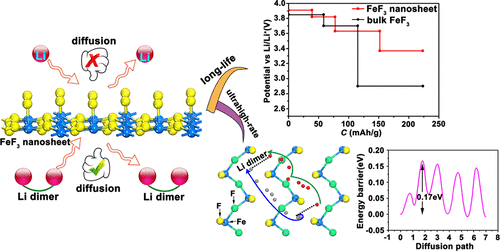当前位置:
X-MOL 学术
›
ACS Appl. Mater. Interfaces
›
论文详情
Our official English website, www.x-mol.net, welcomes your
feedback! (Note: you will need to create a separate account there.)
Atomistic Insights into FeF3 Nanosheet: An Ultrahigh-Rate and Long-Life Cathode Material for Li-Ion Batteries
ACS Applied Materials & Interfaces ( IF 8.3 ) Pub Date : 2018-01-12 00:00:00 , DOI: 10.1021/acsami.7b17127 Zhenhua Yang 1, 2 , Shu Zhao 1, 2 , Yanjun Pan 1, 2 , Xianyou Wang 3 , Hanghui Liu 1, 2 , Qun Wang 1, 2 , Zhijuan Zhang 1, 2 , Bei Deng 4 , Chunsheng Guo 5 , Xingqiang Shi 4
ACS Applied Materials & Interfaces ( IF 8.3 ) Pub Date : 2018-01-12 00:00:00 , DOI: 10.1021/acsami.7b17127 Zhenhua Yang 1, 2 , Shu Zhao 1, 2 , Yanjun Pan 1, 2 , Xianyou Wang 3 , Hanghui Liu 1, 2 , Qun Wang 1, 2 , Zhijuan Zhang 1, 2 , Bei Deng 4 , Chunsheng Guo 5 , Xingqiang Shi 4
Affiliation

|
Iron fluoride with high operating voltage and theoretical energy density has been proposed as a high-performance cathode material for Li-ion batteries. However, the inertness of pristine bulk FeF3 results in poor Li kinetics and cycling life. Developing nanosheet-based electrode materials is a feasible strategy to solve these problems. Herein, on the basis of first-principles calculations, first the stability of FeF3 (012) nanosheet with different atomic terminations under different environmental conditions was systematically studied, then the Li-ion adsorption and diffusion kinetics were thoroughly probed, and finally the voltages for different Li concentrations were given. We found that F-terminated nanosheet is energetically favorable in a wide range of chemical potential, which provide a vehicle for lithium ion diffusion. Our Li-ion adsorption and diffusion kinetics study revealed that (1) the formation of Li dimer is the most preferred, (2) the Li diffusion energy barrier of Li dimer is lower than isolated Li atom (0.17 eV for Li dimer vs 0.22 eV for Li atom), and (3) the diffusion coefficient of Li is 1.06 × 10–6 cm2·s–1, which is orders of magnitude greater than that of Li diffusion in bulk FeF3 (10–13–10–11 cm2·s–1). Thus, FeF3 nanosheet can act as an ultrahigh-rate cathode material for Li-ion batteries. More importantly, the calculated voltage and specific capacity of Li on the FeF3 (012) nanosheet demonstrate that it has a much more stable voltage profile than bulk FeF3 for a wide range of Li concentration. So, few layers FeF3 nanosheet provides the desired long-life energy density in Li-ion batteries. These above findings in the current study shed new light on the design of ultrahigh-rate and long-life FeF3 cathode material for Li-ion batteries.
中文翻译:

FeF 3纳米片的原子学见解:一种用于锂离子电池的超高速率和长寿命阴极材料
已经提出具有高工作电压和理论能量密度的氟化铁作为锂离子电池的高性能阴极材料。然而,原始的原始FeF 3的惰性导致不良的锂动力学和循环寿命。开发基于纳米片的电极材料是解决这些问题的可行策略。在此,基于第一性原理计算,首先是FeF 3的稳定性。(012)系统研究了在不同环境条件下具有不同原子末端的纳米片,然后深入研究了锂离子的吸附和扩散动力学,最后给出了不同浓度的锂的电压。我们发现,F端接的纳米片在广泛的化学势中在能量上是有利的,这为锂离子扩散提供了载体。我们对锂离子的吸附和扩散动力学研究表明,(1)最优选形成Li二聚体,(2)Li二聚体的Li扩散能垒低于孤立的Li原子(Li二聚体为0.17 eV vs 0.22 eV (3)Li的扩散系数为1.06×10 –6 cm 2 ·s –1,这比大量FeF 3(10 –13 –10 –11 cm 2 ·s –1)中Li的扩散大几个数量级。因此,FeF 3纳米片可以用作锂离子电池的超高倍率阴极材料。更重要的是,计算得出的FeF 3(012)纳米片上Li的电压和比电容表明,在宽范围的Li浓度下,Li的电压曲线比块状FeF 3稳定得多。因此,几层FeF 3纳米片可为锂离子电池提供所需的长寿命能量密度。本研究中的上述发现为超高速长寿命FeF的设计提供了新的思路。3用于锂离子电池的正极材料。
更新日期:2018-01-12
中文翻译:

FeF 3纳米片的原子学见解:一种用于锂离子电池的超高速率和长寿命阴极材料
已经提出具有高工作电压和理论能量密度的氟化铁作为锂离子电池的高性能阴极材料。然而,原始的原始FeF 3的惰性导致不良的锂动力学和循环寿命。开发基于纳米片的电极材料是解决这些问题的可行策略。在此,基于第一性原理计算,首先是FeF 3的稳定性。(012)系统研究了在不同环境条件下具有不同原子末端的纳米片,然后深入研究了锂离子的吸附和扩散动力学,最后给出了不同浓度的锂的电压。我们发现,F端接的纳米片在广泛的化学势中在能量上是有利的,这为锂离子扩散提供了载体。我们对锂离子的吸附和扩散动力学研究表明,(1)最优选形成Li二聚体,(2)Li二聚体的Li扩散能垒低于孤立的Li原子(Li二聚体为0.17 eV vs 0.22 eV (3)Li的扩散系数为1.06×10 –6 cm 2 ·s –1,这比大量FeF 3(10 –13 –10 –11 cm 2 ·s –1)中Li的扩散大几个数量级。因此,FeF 3纳米片可以用作锂离子电池的超高倍率阴极材料。更重要的是,计算得出的FeF 3(012)纳米片上Li的电压和比电容表明,在宽范围的Li浓度下,Li的电压曲线比块状FeF 3稳定得多。因此,几层FeF 3纳米片可为锂离子电池提供所需的长寿命能量密度。本研究中的上述发现为超高速长寿命FeF的设计提供了新的思路。3用于锂离子电池的正极材料。











































 京公网安备 11010802027423号
京公网安备 11010802027423号